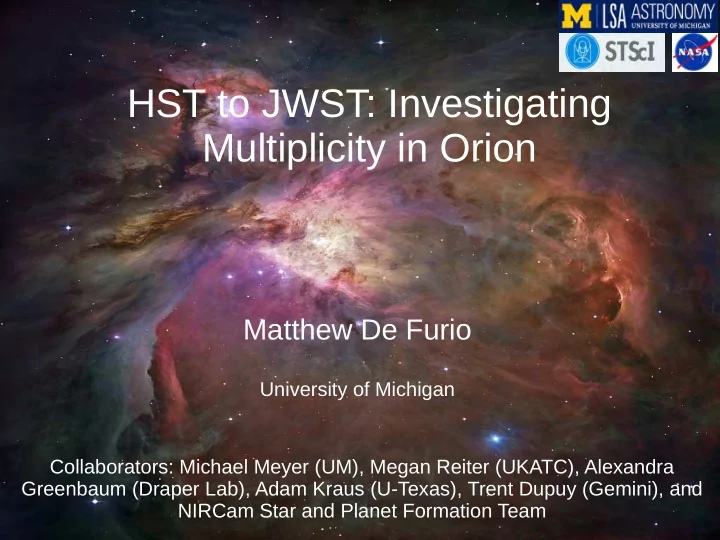

HST to JWST: Investigating Multiplicity in Orion Matthew De Furio University of Michigan Collaborators: Michael Meyer (UM), Megan Reiter (UKATC), Alexandra Greenbaum (Draper Lab), Adam Kraus (U-Texas), Trent Dupuy (Gemini), and NIRCam Star and Planet Formation Team
A Long-Standing Puzzle ● Young, low-mass associations (e.g. Taurus) contain excess of binaries relative to Galactic Field ● Over q from 0-1 and a from 3 – 5000 AU for low-mass primaries: Companion Frequency in Taurus ~ 2x Field ● Do dynamics sculpt binary populations? (Kroupa 1995) Red line is log-normal fit to Field from Duquennoy & Mayor 1991 Blue line is log-normal fit to Taurus from Kraus et al. 2011 ● What about high density regions? Figure: Kraus et al. 2011 – Dynamical interactions more likely – Could affect fragmentation
Studying M-star binaries in the ONC ● Past surveys identify binaries at a > 65 AU and a < 10 AU ● M-stars are important for dynamics because most in number and mass ● No large sample survey of M-star primaries exists ● HST Treasury Program on ONC (Robberto et al. 2013) ● Representative M-star sample from Da Rio et al. 2016 membership survey
Finding Companions Anderson & King 2006 developed position- ● dependent empirical PSFs for ACS We created a binary PSF-fitting algorithm ● Artificial binaries test the sensitivity based on – S/N, contrast, and separation 90% recovery rate is detection threshold – False positives? Not an issue! – Result: 4x better resolution than previous – wide-field surveys (e.g. Reipurth et al. 2007)
We Found 11 New Binaries ● 101 M-star sample ● 14 companions detected
Calculating Galactic Field Companion Frequency Companion Mass Ratio Distribution (CMRD): ● β = 0.25 ± 0.29 Reggiani & Meyer 2013 Surface density distribution: ● ā = 20 AU, σ loga = 1.16 Winters et al. 2019 Expected Companion Frequency: ● Janson et al. 2012
Comparison to Galactic Field ● For low-mass stars, over common q of 0.6 - 1 and a of 30 - 160 AU – Field = 6.5 ± 3%, ONC = 8 ±4/2% – ONC to Field: 0.4σ (M prim = 0.1 – 0.6 M ☉ ) – ONC to Taurus: 1.3σ (M prim = 0.25 – 0.6 M ☉ ) Taurus to Field: 3.0σ over all q and 3-5000 AU for low-mass primaries ● ● No evidence for binary excess in ONC relative to the Field ● Further dynamical evolution of ONC not required to resemble the Field as theorized for young star clusters
NIRCam GTO Imaging of NGC 2024 8 filters for 2.1 hr each ● Determine T eff , log(g), and A V , ● filter out Field stars Expect dozens of 2-20 M J ● Follow-up with NIRSpec to confirm ● membership, T eff , and abundances
Value of JWST in Star Clusters ● See deeper in A v for more sources and probe diverse (central) regions of cloud core ● Extend companion studies to lower q ● Probe binary properties of brown dwarf primaries ● Is brown dwarf CMRD peaked at unity? Fontanive et al. 2018 ● Is there a distinct formation process for BDs vs. stars?
Summary ● Empirical PSF-fitting can find companions at separations below the diffraction limit ● We identified 14 companions in the ONC ● ONC does not have an excess of binaries relative to the Field over q = 0.6 - 1.0 and a = 30 - 160 AU ● Plan to exploit technique on other SFRs ● JWST will reach lower primary mass, and wider range of q, exploring differences between BD and star formation
Recommend
More recommend